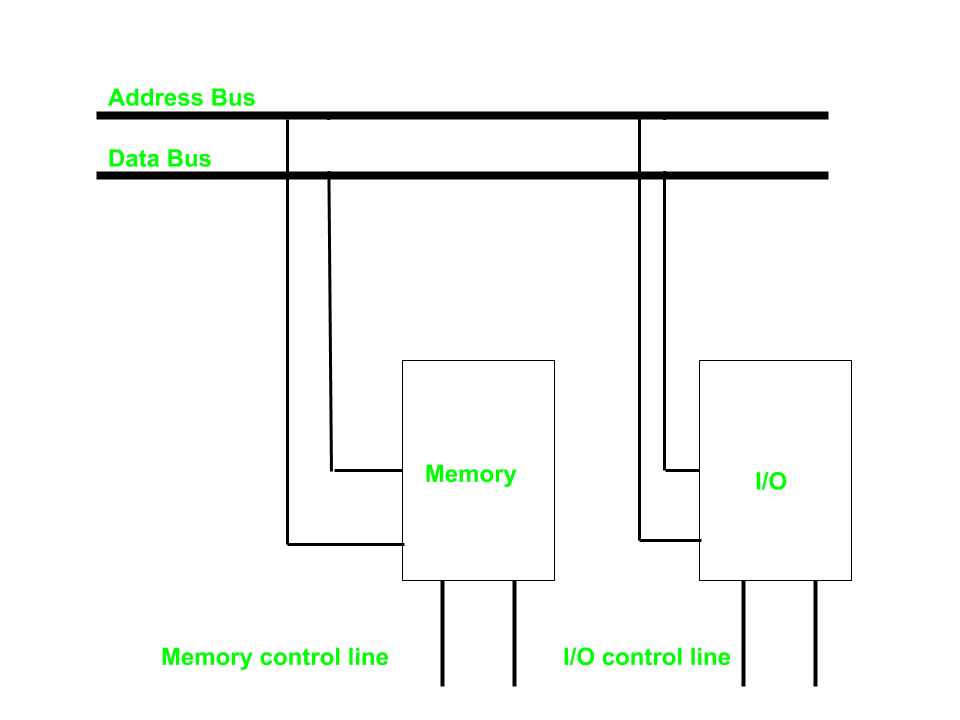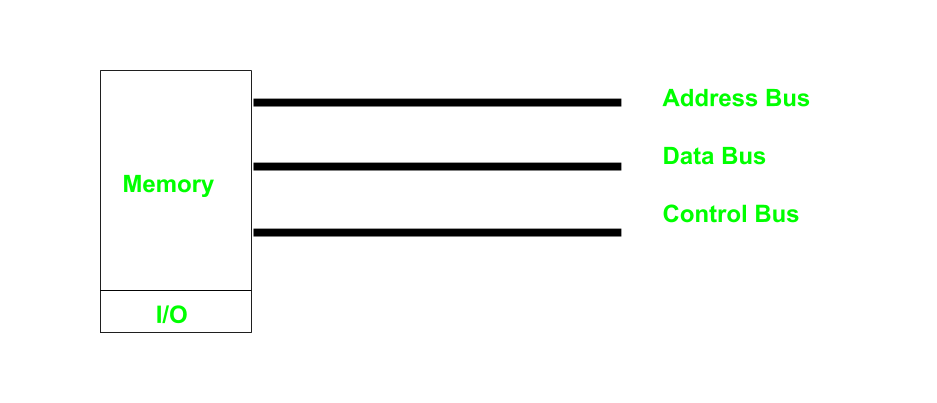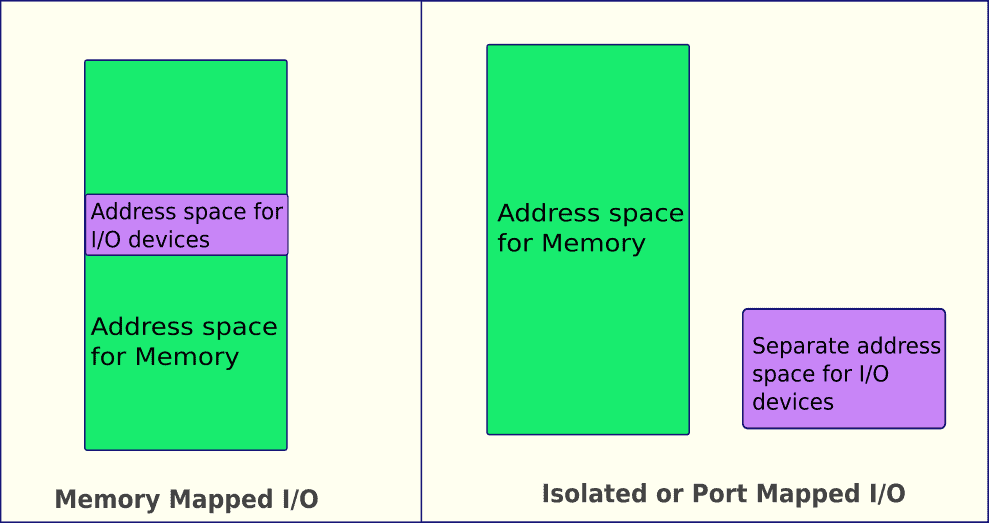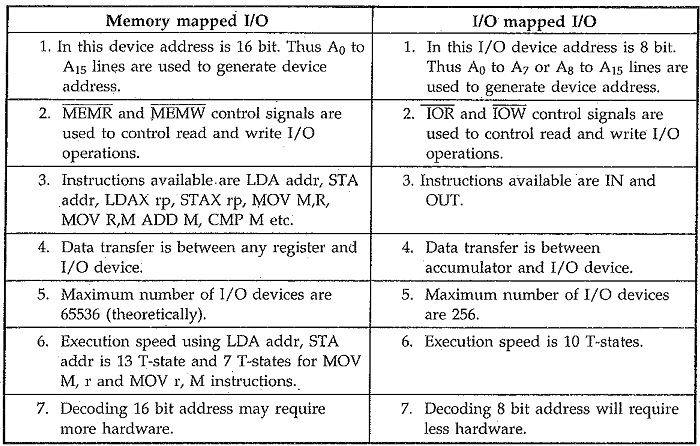Memory mapped I/O and Isolated I/O
As a CPU needs to communicate with the various memory and input-output devices (I/O) as we know data between the processor and these devices flow with the help of the system bus. There are three ways in which system bus can be allotted to them :
- Separate set of address, control and data bus to I/O and memory.
- Have common bus (data and address) for I/O and memory but separate control lines.
- Have common bus (data, address, and control) for I/O and memory.
In first case it is simple because both have different set of address space and instruction but require more buses.
Isolated I/O –
Then we have Isolated I/O in which we Have common bus(data and address) for I/O and memory but separate read and write control lines for I/O. So when CPU decode instruction then if data is for I/O then it places the address on the address line and set I/O read or write control line on due to which data transfer occurs between CPU and I/O. As the address space of memory and I/O is isolated and the name is so. The address for I/O here is called ports. Here we have different read-write instruction for both I/O and memory.

Memory Mapped I/O –
In this case every bus in common due to which the same set of instructions work for memory and I/O. Hence we manipulate I/O same as memory and both have same address space, due to which addressing capability of memory become less because some part is occupied by the I/O. Differences between memory mapped I/O and isolated I/O –
Differences between memory mapped I/O and isolated I/O –
| Isolated I/O | Memory Mapped I/O |
|---|---|
| Memory and I/O have separate address space | Both have same address space |
| All address can be used by the memory | Due to addition of I/O addressable memory become less for memory |
| Separate instruction control read and write operation in I/O and Memory | Same instructions can control both I/O and Memory |
| In this I/O address are called ports. | Normal memory address are for both |
| More efficient due to separate buses | Lesser efficient |
| Larger in size due to more buses | Smaller in size |
| It is complex due to separate logic is used to control both. | Simpler logic is used as I/O is also treated as memory only. |
Advantages of Memory-Mapped I/O:
Faster I/O Operations: Memory-mapped I/O allows the CPU to access I/O devices at the same speed as it accesses memory. This means that I/O operations can be performed much faster compared to isolated I/O.
Simplified Programming: Memory-mapped I/O simplifies programming as the same instructions can be used to access memory and I/O devices. This means that software developers do not have to use specialized I/O instructions, which can reduce programming complexity.
Efficient Use of Memory Space: Memory-mapped I/O is more memory-efficient as I/O devices share the same address space as the memory. This means that the same memory address space can be used to access both memory and I/O devices.
Disadvantages of Memory-Mapped I/O:
Limited I/O Address Space: Memory-mapped I/O limits the I/O address space as I/O devices share the same address space as the memory. This means that there may not be enough address space available to address all I/O devices.
Slower Response Time: If an I/O device is slow to respond, it can delay the CPU’s access to memory. This can lead to slower overall system performance.
Advantages of Isolated I/O:
Large I/O Address Space: Isolated I/O allows for a larger I/O address space compared to memory-mapped I/O as I/O devices have their own separate address space.
Greater Flexibility: Isolated I/O provides greater flexibility as I/O devices can be added or removed from the system without affecting the memory address space.
Improved Reliability: Isolated I/O provides better reliability as I/O devices do not share the same address space as the memory. This means that if an I/O device fails, it does not affect the memory or other I/O devices.
Disadvantages of Isolated I/O:
Slower I/O Operations: Isolated I/O can result in slower I/O operations compared to memory-mapped I/O as it requires the use of specialized I/O instructions.
More Complex Programming: Isolated I/O requires specialized I/O instructions, which can lead to more complex programming.
Applications:
Memory-mapped I/O applications:
Graphics processing: Memory-mapped I/O is often used in graphics cards to provide fast access to frame buffers and control registers. The graphics data is mapped directly to memory, allowing the CPU to read from and write to the graphics card as if it were accessing regular memory.
Network communication: Network interface cards (NICs) often utilize memory-mapped I/O to transfer data between the network and the system memory. The NIC registers are mapped to specific memory addresses, enabling efficient data transfer and control over network operations.
Direct memory access (DMA): DMA controllers employ memory-mapped I/O to facilitate high-speed data transfers between devices and system memory without CPU intervention. By mapping the DMA controller registers to memory, data can be transferred directly between devices and memory, reducing CPU overhead.
Isolated I/O applications:
Embedded systems: Isolated I/O is commonly used in embedded systems where strict isolation between the CPU and peripherals is necessary. This includes applications such as industrial control systems, robotics, and automotive electronics. Isolation ensures that any faults or malfunctions in peripheral devices do not affect the stability of the entire system.
Microcontrollers: Microcontrollers often rely on isolated I/O to interface with various peripherals, such as sensors, actuators, and displays. Each peripheral is assigned a separate I/O port, allowing the microcontroller to control and communicate with multiple devices independently.
Real-time systems: Isolated I/O is preferred in real-time systems that require precise timing and deterministic behavior. By isolating the I/O operations, these systems can maintain strict control over the timing and synchronization of external events, ensuring reliable and predictable performance.
Difference between Memory Mapped IO and IO Mapped IO with reference to 8085 microprocessor
In the field of microprocessor architectures, Input/Output (I/O) operations are primitive for communicating with peripheral equipment. The 8085 microprocessor employs two primary methods for handling I/O operations: Memory Mapped I/O Versus I/O Mapped I/O. It is essential to become familiar with the distinctions existing between these two types of approaches for the purpose of designing efficient systems. This article focuses both techniques, characterizing them, illustrating their gains and losses, in addition to analyzing their implementation within the context of the 8085 microprocessor.
What is Memory Mapped I/O?
Memory Mapped I/O is a technique in which an I/O device is mapped as memory itself. In this approach, memory and I/O devices occupy the same space as far as the system is concerned. This implies that the CPU can transmits or receive data from I/O devices using the same format that is used to address normal memory.
Characteristics of Memory Mapped I/O
- Shared Address Space: I/O devices are carved out a particular memory space.
- Unified Instructions: They are identical for both memory and I/O operations.
- Simplified Addressing This means there is no need for special instructions and port for I/O operations as in integrated I/O.
Advantages of Memory Mapped I/O
- Faster Access: Because a memory has faster access times then an I/O operation can have improved access times as well.
- Flexible Addressing: Supports all the addressing modes of the CPU hence making it easier to write programs.
- Simplified Programming Model: Unlike other instruction types, where the Developer requires a special kind of instruction called I/O instruction, they are free to use what is called memory instruction.
Disadvantages of Memory Mapped I/O
- Limited Address Space: It was also pointed out that sharing the address space between memory and I/O can reduce the number of available memory addresses.
- Complexity in Address Decoding: needs extra software logic in order to distinguish between memory accesses and I/O operations.
- Potential for Address Conflicts: Possibility of the existence of similar addresses if not controlled properly.
What is I/O Mapped I/O?
I/O Mapped I/O known as Port Mapped I/O uses dedicated address space for the installation of I/O devices. This method employs specific port commands by which it addresses I/O ports hence enhancing the segregation between memory and ports.
Advantages of I/O Mapped I/O
- Separate Address Space: I/O devices are granted their own address space that is independent of the memory space of the computer.
- Dedicated Instructions: Contains specific I/O instructions known as `IN` and `OUT`.
- Distinct Port Addresses: I/O devices are connected to the computer and can only be addressed by specific port addresses.
Advantages of I/O Mapped I/O
- Expanded Address Space: Preserves memory address space full for the memory operations use, to avoid any conflict.
- Simplified Address Decoding: Hence, it lowers the ontological level seen in previous models and clears the memory –I/O barrier making the model less complex.
- Security and Stability: decreases the possibility of an authority or a code somehow getting the memory’s address and accessing it through I/O channels.
Disadvantages of I/O Mapped I/O
- Slower Access: I/O operations may be slower because of the use of special instruction.
- Limited Addressing Modes: Limited to the addressing modes of I/O instructions; thus the flexibility is somewhat hampered.
- Increased Instruction Set: Needs further instructions which adds to the intricate instruction set architecture.
Difference between Memory-Mapped I/O Interfacing and I/O Mapped I/O Interfacing :
| Features | Memory Mapped IO | IO Mapped IO |
|---|---|---|
| Addressing | IO devices are accessed like any other memory location. | They cannot be accessed like any other memory location. |
| Address Size | They are assigned with 16-bit address values. | They are assigned with 8-bit address values. |
| Instructions Used | The instruction used are LDA and STA, etc. | The instruction used are IN and OUT. |
| Cycles | Cycles involved during operation are Memory Read, Memory Write. | Cycles involved during operation are IO read and IO writes in the case of IO Mapped IO. |
| Registers Communicating | Any register can communicate with the IO device in case of Memory Mapped IO. | Only Accumulator can communicate with IO devices in case of IO Mapped IO. |
| Space Involved | 216 IO ports are possible to be used for interfacing in case of Memory Mapped IO. | Only 256 I/O ports are available for interfacing in case of IO Mapped IO. |
| IO/M` signal | During writing or read cycles (IO/M` = 0 ) in case of Memory Mapped IO. | During writing or read cycles (IO/M` = 1) in case of IO Mapped IO. |
| Control Signal | No separate control signal required since we have unified memory space in the case of Memory Mapped IO. | Special control signals are used in the case of IO Mapped IO. |
| Arithmetic and Logical operations | Arithmetic and logical operations are performed directly on the data in the case of Memory Mapped IO. | Arithmetic and logical operations cannot be performed directly on the data in the case of IO Mapped IO. |
| Hardware requirements | Only one set of address and data buses are required for memory and I/O devices | Separate address and data buses are required for memory and I/O devices |
| Instruction set | Uses the same instructions for accessing both memory and I/O devices | Special instructions are used for accessing I/O devices |
| Address range | Limited number of memory locations available for use by the microprocessor | Dedicated address space available for I/O devices |
| Design complexity | Simple to implement and design | More complex to implement and design |
FAQ’s
Which of I/O method is most widely used in today’s microprocessors?
Memory Mapped I/O is found more frequently in the contemporary microprocessors because of the high flexibility and the possibility to perform I/O operations using the instructions of the MEMORY type. But some systems still utilize I/O Mapped I/O for special cases where a definite separation of address space is necessary.
Is it possible to use Memory Mapped I/O and I/O Mapped I/O simultaneously in the sam\e system?
It is also true that two methods can be integrated into a system so that the one best suits the application is used in the system. This increases the possibility and optimization flexibility compared to the two extreme pure approaches.
Memory Mapped I/O refers to a method employed by the 8085 microprocessor to complete I/O operations through the same gates as those used for accessing the memory.
Memory Mapped I/O is done on the 8085 microprocessor, in a way that, specific addresses in the memory are used for I/O operations. These addresses are normal memory addresses to which, for example, the CPU sends/receives data using normal memory read/write instructions, thus communicating with I/O devices.
What is the fundamental different between Memory Mapped I/O and I/O Mapped I/O?
Memory Mapped I/O employs ‘normal’ processes (instructions such as ‘MOV’, ‘LOAD’, ‘STORE’, etc.) employed by a typical processor for reading and writing operations; in contrast, I/O Mapped I/O employs differently coded instructions referred to typically as the ‘IN’ and ‘OUT’ instructions.



Comments
Post a Comment